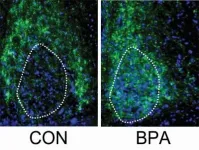(Press-News.org) Humans are exposed to a bath of chemicals every day. They are in the beds where we sleep, the cars that we drive and the kitchens we use to feed our families. With thousands of chemicals floating around in our environment, exposure to any number is practically unavoidable. Through the work of researchers like Dr. Deborah Kurrasch, PhD, the implications of many of these chemicals are being thoroughly explored.
"Manufacturers follow standards set by regulatory bodies, it's not up to the manufacturers to prove the chemicals in consumer products are safe," says Kurrasch, a researcher in the University of Calgary's Hotchkiss Brain Institute (HBI) and Alberta Children's Research Institute at the Cumming School of Medicine. "Scientists play a critical role and do the meticulous work of determining where the risks lie."
Kurrasch's research over the past decade has focused on a chemical that is broadly recognizable: Bisphenol A, also known as BPA. This chemical is commonly found in plastics, canned food linings, and even thermal receipts. Studies from Kurrasch's lab contribute to the collective research that shows the harms of exposure to this industrial compound.
The latest study out of Kurrasch's lab, published in Science Advances, suggests that continued vigilance is needed. A postdoctoral researcher in her lab, Dr. Dinu Nesan, PhD, examined the impact of low levels of BPA exposure to pregnant mice and the brain development of their offspring.
"Our goal was to model BPA levels equivalent to what pregnant women and developing babies are typically exposed to," says Kurrasch. "We purposefully did not use a high dose. In fact, our doses were 11-times and nearly 25-times lower than those deemed safe by Health Canada and the FDA (U.S. Food and Drug Administration), respectively. Even at these low levels, we saw effects on prenatal brain development in the mice."
Using this BPA exposure model, Nesan found striking changes to the brain region responsible for driving circadian rhythms, the suprachiasmatic nucleus, located in the hypothalamus. When prenatally exposed to these low levels of BPA, the suprachiasmatic nucleus failed to develop properly. This change can have implications for sleep, activity levels, and other behaviours.
"Previously we showed embryonic exposure to low-dose BPA can affect the timing of when neurons develop in zebrafish, but it was unclear whether a similar effect would be observed in a mammalian model with more similarities to humans," says Nesan, first author on the study. When neurons develop, they rely on proper signals to guide them. If neurons develop too early, the cues they experience are different, which can lead to developmental errors such as migrating to the wrong location, becoming the wrong type of neuron, or forming inappropriate connections. These errors can lead to altered behaviors later in life.
"Our study shows that in pregnant mice, prenatal exposure to BPA affects the timing of neuron development in the fetal brain, which has lasting effects on behaviours. Offspring that are exposed to BPA during gestation are awake longer and exhibit hyperactivity. The prenatal BPA exposure seems to change the brain's circadian cues, causing the animals to have elevated energy levels and spend less time resting," says Nesan.
The researchers are hopeful their findings will add continued pressure on regulatory bodies to keep revisiting their determinations around safe levels of BPA.
"We think there's an incredible abundance of data showing BPA exposure guidelines are not yet at the appropriate level, which includes even the EU (European Union) who is leading on this front, but their 'safe' levels are still twice the dose we used in our study" says Kurrasch, "We hope our research serves as a reminder that low dose BPA is still capable of causing changes that are measurable and significant."
Her message of how to interpret this research is simple:
Limit your exposure to BPA the best you can.
Maintain smart practices with plastics in your kitchen, for example not heating them, and using glass or stainless steel when possible.
This research was conducted in collaboration with Dr. Michael Antle, PhD, professor of psychology and member of the HBI.
INFORMATION:
Right-wing voices set out powerful but misleading arguments to justify inaction by the Trump administration during the COVID-19 pandemic, according to a new study of the rhetoric used by high-level government officials and influential commentators in the US during the first half of 2020.
In a study published in the DeGruyter journal Open Anthropological Research, Professor Martha Lincoln of San Francisco State University examined how public officials openly pushed for people to accept widespread illness and death from the virus by adopting a tone that suggested premature death was normal and the scale of death acceptable in the grander ...
RUDN mathematician and his colleagues from China, Egypt, Saudi Arabia, United Kingdom, and Qatar have developed an algorithm allowing the distribution of computing tasks between the IoT devices and the cloud in an optimal way. As a result, the power and time costs are reduced by about three times. The study was published in the Big Data.
With the development of technologies and devices, Internet of Things (IoT) applications require more and more computing power. The amount of data that the IoT devices need to process can be so large that it is reasonable to migrate computing to the cloud. Cloud computing provides flexible data processing and storage capabilities. But Computation offloading, meaning transferring of the resource-intensive processes ...
A DTU research team consisting of Malgorzata Gosia Pierchala, Firoz Babu Kadumundi, and Mehdi Mehrali from #TeamBioEngine headed by Alireza Dolatshahi-Pirouz, have developed a new material - CareGum - that among other things has potential for monitoring motor impairment associated with neurological disorders such as Parkinson's.
A green material with many properties
The CareGum property portfolio is incredibly broad with feats such as skin-like softness, it is stretchable up to 30,000 % and has self-healing capacities reminiscent of that of natural tissues. It is printable, moldable, and electrically conductive. Notably, the electrical conductivity enables the material to respond to external stimuli ...
Oncotarget published "STAT3 induces the expression of GLI1 in chronic lymphocytic leukemia cells" which reported that what induces GLI1 expression in GLI1-unmutated CLL cells is unknown.
Because signal transducer and activator of transcription 3 is constitutively activated in CLL cells and sequence analysis detected putative STAT3-binding sites in the GLI1 gene promoter, the authors hypothesized that STAT3 induces the expression of GLI1.
Western immunoblotting detected GLI1 in CLL cells from 7 of 7 patients, flow cytometry analysis confirmed that CD19 /CD5 CLL cells co-express GLI1 and confocal microscopy showed co-localization of GLI1 and phosphorylated STAT3. Chromatin immunoprecipitation showed ...
A series of autopsies performed in an infectious disease hospital in the Brazilian Amazon reveals that infections by the Histoplasma fungus are a major cause of death in people with HIV. The study, led by Barcelona Institute for Global Health (ISGlobal), an institution supported by "la Caixa" Foundation, in collaboration with a team in Manaus, highlights the need of implementing sensitive methods to detect these infections in Histoplasma-endemic regions.
Histoplasmosis is a lung infection caused by inhalation of spores from a fungus (Histoplasma), and is frequent in some areas of the US, Africa, and Latin America.
In the majority of individuals with a functional immune system, the infection causes mild symptoms. However, in people who are immuno-compromised, such ...
Scientists at Kyoto University's Institute for Integrated Cell-Material Sciences (iCeMS) in Japan have developed a technology that produces high-resolution simulations of one of the basic units of our genomes, called the nucleosome. Their findings were published in the journal Nature Protocols and should help improve understanding of how changes in nucleosome folding influence the inner workings of genes.
Nucleosomes are the basic structural units of DNA packaging inside the nucleus. They are formed of DNA wrapped around a small number of histone proteins. Nucleosomes move around inside the nucleus, folding and unfolding, changing their orientations, and moving closer together or further apart. These movements affect the accessibility of various molecules to DNA, determining ...
A new discovery in Ewing sarcoma, an aggressive and often fatal childhood cancer, has uncovered the potential to prevent cancer cells from spreading beyond their primary tumour site.
The breakthrough provides new insight into what triggers the process that allows cancer cells to survive while traveling through the body in the bloodstream.
Researchers with the University of British Columbia and BC Cancer have learned that Ewing sarcoma cells--and likely other types of cancer cells--are able to develop a shield that protects them from the harsh environment of the bloodstream and other locations as they search for a new place to settle, or metastasize. The study has just been published in Cancer Discovery.
"You ...
TROY, N.Y. -- As more dissolved organic matter enters lakes across the northeast United States, darkening the lakes in a phenomena called "browning," new research shows that these waters may be growing less productive and able to sustain less life. In a study published today in Limnology and Oceanography Letters, scientists found that, rather than enriching lakes with nutrients as had previously been assumed, water more heavily laden with dissolved organic matter blocks sunlight and limits plant growth.
"A key question regarding lake browning is what impact it will have on aquatic food webs, including algal growth and fisheries," said Kevin Rose, co-author ...
The brain is often likened to a computer: its hardware - neurons organized in complex circuits, its software - a plethora of codes that govern the neurons' behavior. But sometimes the brain performs exceptionally well even when its hardware seems inadequate for the task. For example, it's been puzzling how we and other mammals manage to navigate large-scale environments even though the brain's spatial perception circuits are seemingly suited to representing much smaller areas. A team of researchers from the Weizmann Institute of Science, led by Prof. Nachum Ulanovsky of the Neurobiology Department, tackled this riddle by thinking outside the experimental box. By combining an unusual research model - fruit bats - with an unusual setting - a 200 meters-long bat-tunnel - they were ...
The genetic material of most organisms is carried by DNA, a complex organic molecule. DNA is very long -- for humans, the molecule is estimated to be about 2 m in length. In cells, DNA occurs in a densely packed form, with strands of the molecule coiled up in a complicated but efficient space-filling way. A key role in DNA's compactification is played by histones, structural-support proteins around which a part of a DNA molecule can wrap. The DNA-histone wrapping process is reversible -- the two molecules can unwrap and rewrap -- but little is known about the mechanisms at play. Now, by applying high-speed atomic-force microscopy (HS-AFM), Richard ...






